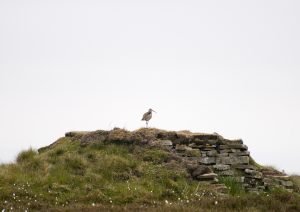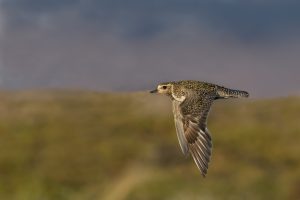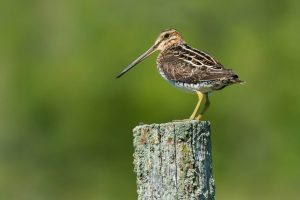28th November 2017
The Moorland Association has welcomed a new report by the British Trust for Ornithology that highlights the key role that grouse moor gamekeepers can play in the monitoring and conservation of thriving upland wader populations.
The report details a pilot project in Wensleydale in the Yorkshire Dales National Park which trialled methods for involving gamekeepers and farmers in surveying breeding waders and monitoring the hatching success of nests.
The report revealed high densities of breeding Curlew, Golden Plover, Lapwing, Redshank and Snipe in the upland project area covering moorland and farm land.

Curlew on a grouse butt
Thirty-four nests were monitored with cameras and temperature recorders to pinpoint egg hatching or failure. Overall, six out of every ten nests hatched chicks. Of the thirteen nests that failed, ten nests were predated, mainly by sheep, hedgehogs and badgers, or trampled by livestock. There was no fox or small mammal predation recorded and only one nest fell victim to crows.
The survey asked gamekeepers, which were based at the Bolton Castle Estate, to monitor breeding waders in the course of their routine work during the breeding season. The gamekeeper’s work was found to be very similar to that of independent BTO staff.
Amanda Anderson, Director of the Moorland Association, welcomed the report’s findings: “This report is hugely encouraging. It clearly states gamekeepers can be enthusiastic and accurate ‘citizen scientists’ in gathering information on breeding waders. It is also very heartening to see the reputation of grouse moors as strongholds for a wide range of waders is underpinned by the findings of this report.
Other research has found that in moorland areas where there are gamekeepers controlling generalist predators like foxes, crows and stoats there are up to five times as many waders which have a three times better chance of fledging their chicks.”

Golden Plover in flight
David Jarrett, who led on the project for the BTO, said “This work demonstrates the considerable potential of working with different stakeholders to monitor our threatened breeding wader populations. Gamekeepers interested in carrying out breeding wader surveys may be able to generate data comparable to that of experienced fieldworkers if good guidance and training is made available. Projects around the UK, which are seeking to monitor breeding waders, could benefit both from these piloted survey methods and from the provision of guidance to allow a wide range of stakeholders to contribute to survey work.”
A spokesperson for Bolton Castle estate said: “We were delighted to take part in this important trial. Moorland gamekeepers have a wealth of knowledge and field skills and are very proud of the assemblage, abundance and success of ground nesting birds on their patch. Harnessing this motivation to record what they see whilst going about day to day duties has been a relatively simple and enjoyable step that could be rolled out to other areas.”
Wildlife Officer at the Yorkshire Dales National Park Authority, Ian Court, said: “The enthusiastic way in which the gamekeepers took to monitoring is really encouraging. Those that took part in this research already knew a lot about the birds and could distinguish between different species, calls, songs and behaviours. As gamekeepers are on the moor for a significant proportion of their working day, they are ideally placed to help survey breeding waders. The Authority hopes that all stakeholders can build on the success of this research, with a view to establishing more coordinated survey work across the national park.”

Snipe
The British Trust for Ornithology ‘Monitoring Breeding Waders in Wensleydale: trialling surveys carried out by farmers and gamekeepers’ report can be found on the BTO website here








